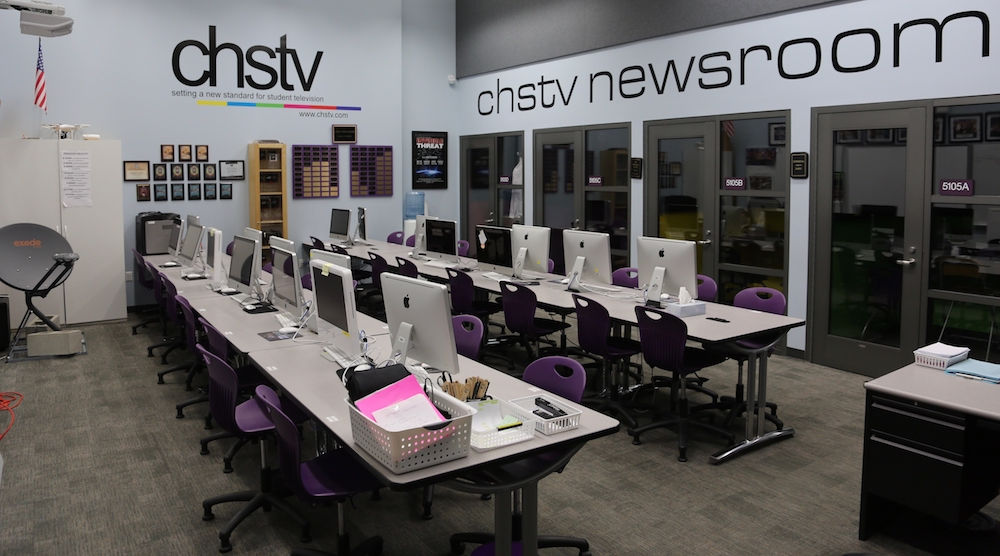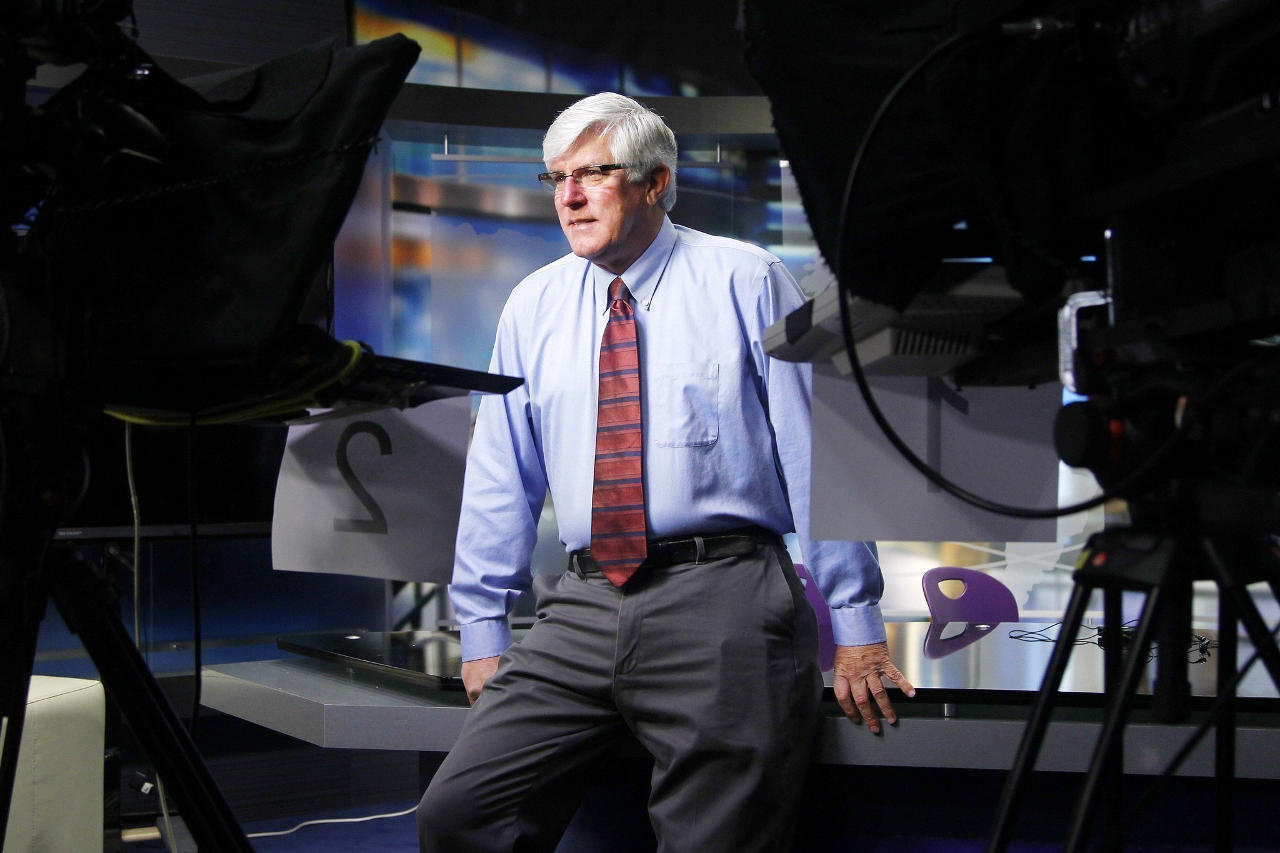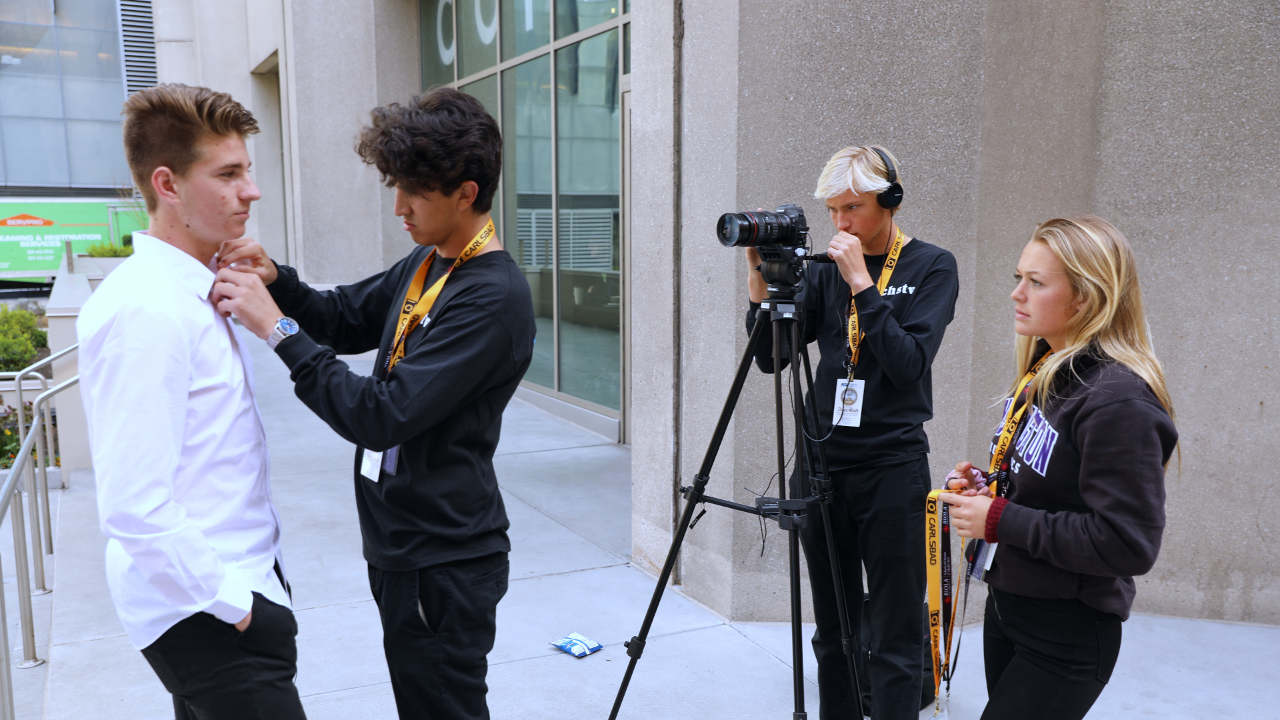BACK OFFICE BUSINESS: Carlsbad High School’s Award-Winning CHSTV Broadcast Journalism Program
The students run the entire show. They work as on-camera talent and news anchors, and execute the live show from the control room.

One of the most impressive broadcast curriculums in the nation is located in Carlsbad, California – not at a college, however, but at Carlsbad High School. The prowess of the school’s Broadcast Journalism Program, branded CHSTV, is seen in its daily productions, its PBS documentary specials, and at the annual STN nationwide student broadcasting competition – where CHSTV has consistently won “Best Daily Newscast in the Nation” since 2008.
CHSTV’s newscasts are tightly crafted, visually infectious, professional grade, and produced entirely by students. Packed with live studio and field reports, guest interviews, and special interest features, each show delivers information the students feel their peers need to know. The 12-minute high definition newscast is seen live via the web, in classrooms through closed circuit television, and across the Carlsbad area over local cable systems.

At 7:30 a.m. students arrive with no content prepared and with no idea of what role they will play in that morning’s newscast. A brainstorming session is held with CHSTV Broadcast Teacher Douglas Green, and the students then begin researching topics, writing copy, gathering imagery, creating graphics, and editing video. By 9 a.m., there’s a quick run-through, and by 9:18 am – without fail – the news goes live.
The students run the entire show. They work as on-camera talent and news anchors, and execute the live show from the control room.
News Training Ground

Green — named 2016 California Teacher of the Year — formed CHSTV in 2002 as a means to give students who were learning video and broadcasting at the district’s three middle schools a continuing education in the trade. Today, 90 percent of the students in the CHSTV program come from those middle school programs.
Along with working in each technical position—both in front of and behind the camera—during the grading period, students also take turns delivering an interactive presentation using the Magic Window – a giant touch screen monitor. The students are also expected to produce a feature segment on any topic of their choice every three weeks. On deadline day, several student/content producers evaluate the video clips for use in the newscast as well as grade the work.

The demand for the program is high, and Green teaches two different classes of students according to a rotating block schedule. This means there may be 12 or more students in the studio serving as anchors, interviewers, camera operators, floor directors, teleprompter operators, and production assistants, with many more in the control room serving as technical directors, producers, and graphics operators. The key, Green says, is they must all communicate clearly and effectively with each other in order to have a successful outcome.
Tools and ideas to transform education. Sign up below.
“One reason we’ve been so successful is that we attract students who really have a passion for telling stories, and who embrace this concept that, as journalists, we are the voice for the voiceless,” Green added.
This is especially true for the documentary films the students have produced on such hot topics as vaccines, food banks for struggling military families, and interesting jobs for the new era of work.
The result of the curriculum’s educational and technical goals is a combination of real-world skills used in broadcasting and video creation with educational information delivered to the students in the district. Upon high school graduation, CHSTV students typically go on to study broadcast journalism and other media arts at the university level.
Building a Broadcast-Quality Facility
The documentary work is commissioned by professional organizations and corporations. The students pick the projects that interest them, and this work generates vital revenue that funds the CHSTV program. Other sources of revenue include grants, fundraising, and a parents’ booster club. Together, this income helps defray the many onerous, on-going production costs.
CHSTV also has a 501c3 non-profit designation, meaning it’s easier and more appealing for broadcast technology companies to donate equipment to the program since it’s tax deductible. The region is also rich with broadcast news professionals and engineers that occasionally offer their advice and technical expertise.
This allows CHSTV’s aspiring journalists to hone their technical and soft skills to the point where they are immediately valuable to any broadcast news, sports, or network TV operation.

Situated side-by-side in the control room, two “dueling” NewTek TriCasters are used to roll live video opens and packages, and to switch and stream the show. A third TriCaster is used to live stream sports and special events from remote locations, while a fourth is kept in storage as a back-up. A companion TriCaster technology, called Live Text, is used to create broadcast graphics, such as lower third supers.
“The TriCaster is just a wonderful piece of equipment that gives our kids the opportunity to create freely on the fly. It’s sophisticated and full-featured, yet user-friendly for kids to learn quickly,” Green said. “It’s the foundation of a program that lets kids develop their creativity, character, and collaboration skills as they work in partnership to tell stories that they hope will make the world a better place.”

The adjacent, 900 square foot studio is equipped with two Panasonic P2HD studio cameras on dollies, a Canon C300 DSLR camera on a crane, two Sony XDCAM 4K camcorders, a GoPro, as well as a wireless, handheld Ronin-S “Fly Cam” that serves as a Steadicam to fluidly follow the action. The studio has a large anchor desk, an overhead lighting grid, two large video wall displays at the back of the set, and ample space for students to conduct guest interviews while seated on the comfy furniture or walking around the set.
Live feeds are brought in from additional cameras at remote locations—such as local events, restaurants, public places and sports venues—via satellite. This equipment, courtesy of a generous donation by ViaSat Corporation, includes two satellite uplinks that reside on the roof of the high school and its nearby stadium. Using this satellite gear, the students can transmit video signals at high-speed via a satellite. At remote locations, the students also use a Dejero bonded cellular transmission system to back-haul their live video signal to the studio for inclusion in the newscast.
“The studio is equipped with a full editing lab. Each computer contains Final Cut X and the Adobe Production Suite,” said Student Producer/Journalist Kelsey Beekman. “Students can use these computers to edit their stories, do research, and to find upcoming events to cover. Our newsroom is also furnished with four soundproof editing bays perfect for editing stories and recording voice-overs. We’re grateful to have a studio that helps students produce their best work.”
“When a student first begins to learn the TriCaster system, they partner with more experienced students, and within an hour they’re operating at full capacity for a live show,” said Nick Francis, a junior in the CHSTV program. “When I was in the control room and switching a live show for the first time, I was biting my nails. I was super nervous…but came out the other side alive! And now, whenever I face a challenging new situation, I’m able to handle myself with so much more poise and confidence.”
While CHSTV Sophomore Miles Fesler serves as a TriCaster trainer to other students, he’s still discovering amazing things about it. After he trains one student, that student pays it forward by teaching other students. “This shows how great the TriCaster is as a new piece of technology that lets anyone pick it up relatively quickly. We can have eight different cameras that can be switched in an instant. This lets us have a lot of flexibility in our show, and really lends itself to a really great broadcast.”
EQUIPMENT LIST
The following gear is used by CHSTV at Carlsbad High School:
- An on-set video wall display
- An interactive “Magic Window” touch screen
- Four NewTek TriCasters (various models)
- Computer Lab/classroom equipped with Adobe Production Suite and Final Cut X at each station
- NewTek Live Text CG software
- Four soundproof bays for editing, audio and voice-over recording
- A large, 900 square-foot studio with anchor desk and furniture
- A lighting grid suspended from the studio ceiling
- Multiple cameras, including two Panasonic P2HD studio cameras on dollies
- Two Sony 4K camcorders
- A Canon C300 DSLR camera on a crane
- A GoPro
- Ronin-S Fly Cam wireless camera system
- Microphones, including wireless mics
- ViaSat satellite uplink equipment
- Dejero bonded cellular transmission system
